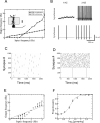Effects of synaptic synchrony on the neuronal input-output relationship
- PMID: 18254692
- PMCID: PMC4339285
- DOI: 10.1162/neco.2008.10-06-385
Effects of synaptic synchrony on the neuronal input-output relationship
Abstract
The firing rate of individual neurons depends on the firing frequency of their distributed synaptic inputs, with linear and nonlinear relations subserving different computational functions. This letter explores the relationship between the degree of synchrony among excitatory synapses and the linearity of the response using detailed compartmental models of cortical pyramidal cells. Synchronous input resulted in a linear input-output relationship, while asynchronous stimulation yielded sub- and supraproportional outputs at low and high frequencies, respectively. The dependence of input-output linearity on synchrony was sigmoidal and considerably robust with respect to dendritic location, stimulus irregularity, and alteration of active and synaptic properties. Moreover, synchrony affected firing rate differently at lower and higher input frequencies. A reduced integrate-and-fire model suggested a mechanism explaining these results based on spatiotemporal integration, with fundamental implications relating synchrony to memory encoding.
Figures


Similar articles
-
Computational simulation of the input-output relationship in hippocampal pyramidal cells.J Comput Neurosci. 2006 Oct;21(2):191-209. doi: 10.1007/s10827-006-8797-z. Epub 2006 Jul 25. J Comput Neurosci. 2006. PMID: 16871350
-
Synaptic integration gradients in single cortical pyramidal cell dendrites.Neuron. 2011 Mar 10;69(5):885-92. doi: 10.1016/j.neuron.2011.02.006. Neuron. 2011. PMID: 21382549 Free PMC article.
-
Active dendrites enable strong but sparse inputs to determine orientation selectivity.Proc Natl Acad Sci U S A. 2021 Jul 27;118(30):e2017339118. doi: 10.1073/pnas.2017339118. Proc Natl Acad Sci U S A. 2021. PMID: 34301882 Free PMC article.
-
Dendritic integration of excitatory synaptic input.Nat Rev Neurosci. 2000 Dec;1(3):181-90. doi: 10.1038/35044552. Nat Rev Neurosci. 2000. PMID: 11257906 Review.
-
Role of dendritic synapse location in the control of action potential output.Trends Neurosci. 2003 Mar;26(3):147-54. doi: 10.1016/S0166-2236(03)00035-3. Trends Neurosci. 2003. PMID: 12591217 Review.
Cited by
-
The Impact of Multivesicular Release on the Transmission of Sensory Information by Ribbon Synapses.J Neurosci. 2022 Dec 14;42(50):9401-9414. doi: 10.1523/JNEUROSCI.0717-22.2022. Epub 2022 Nov 7. J Neurosci. 2022. PMID: 36344266 Free PMC article.
-
Trem2 expression in microglia is required to maintain normal neuronal bioenergetics during development.Immunity. 2024 Jan 9;57(1):86-105.e9. doi: 10.1016/j.immuni.2023.12.002. Epub 2023 Dec 29. Immunity. 2024. PMID: 38159572 Free PMC article.
-
Estimating cortical column sensory networks in rodents from micro-electrocorticograph (μECoG) recordings.Neuroimage. 2017 Dec;163:342-357. doi: 10.1016/j.neuroimage.2017.09.043. Epub 2017 Sep 23. Neuroimage. 2017. PMID: 28951350 Free PMC article.
-
Feed-forward inhibition as a buffer of the neuronal input-output relation.Proc Natl Acad Sci U S A. 2009 Oct 20;106(42):18004-9. doi: 10.1073/pnas.0904784106. Epub 2009 Oct 8. Proc Natl Acad Sci U S A. 2009. PMID: 19815518 Free PMC article.
-
Modulation of hippocampal rhythms by subthreshold electric fields and network topology.J Comput Neurosci. 2013 Jun;34(3):369-89. doi: 10.1007/s10827-012-0426-4. Epub 2012 Oct 7. J Comput Neurosci. 2013. PMID: 23053863 Free PMC article.
References
-
- Ascoli GA. Mobilizing the base of neuroscience data: the case of neuronal morphologies. Nat Rev Neurosci. 2006;7:318–24. - PubMed
-
- Barnes CA, McNaughton BL, Mizumori SJ, Leonard BW, Lin LH. Comparison of spatial and temporal characteristics of neuronal activity in sequential stages of hippocampal processing. Prog Brain Res. 1990;83:287–300. - PubMed
-
- Bernander O, Koch C, Usher M. The effects of synchronized inputs at the single neuron level. Neural Comput. 1994;6:622–41.
-
- Buzsaki G. Two-stage model of memory trace formation: a role for “noisy” brain states. Neuroscience. 1989;31:551–70. - PubMed
-
- Buzsaki G. Large-scale recording of neuronal ensembles. Nat Neurosci. 2004;7:446–51. - PubMed
Publication types
MeSH terms
Grants and funding
LinkOut - more resources
Full Text Sources
Molecular Biology Databases

